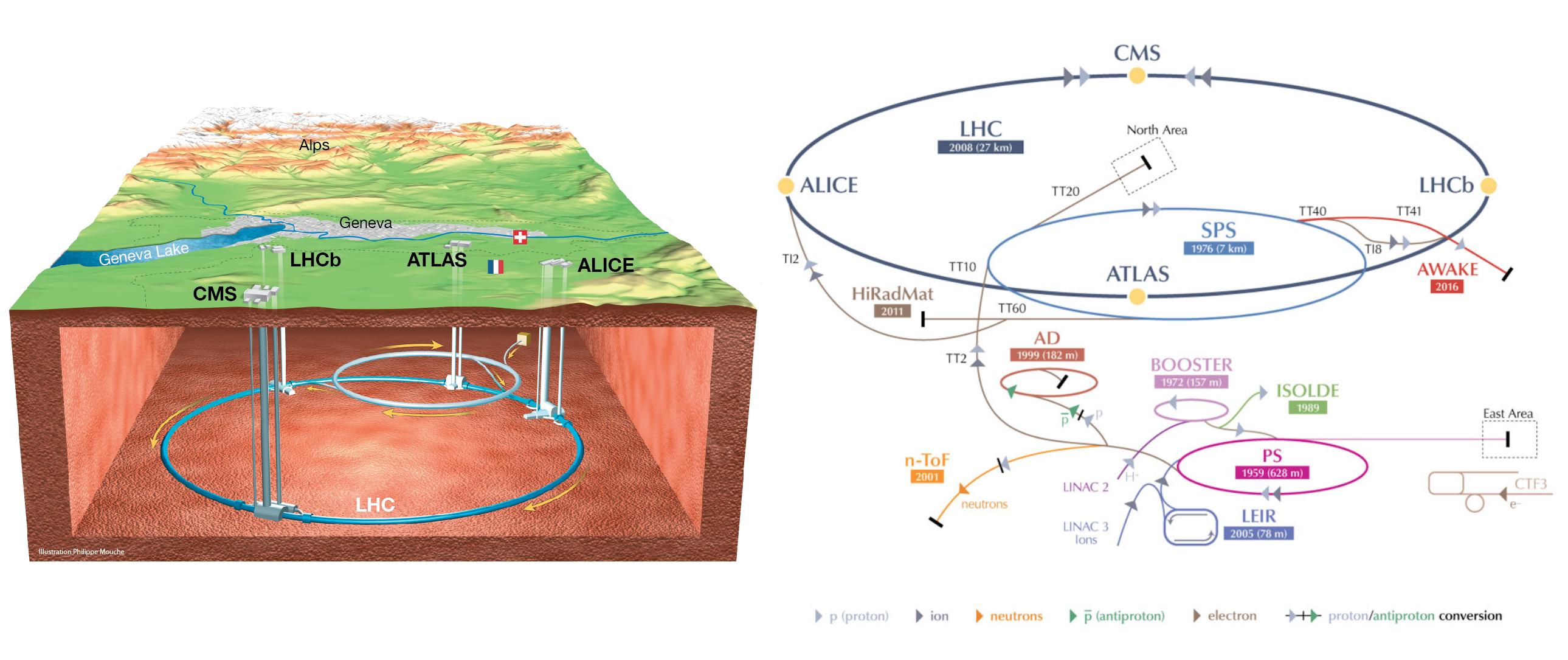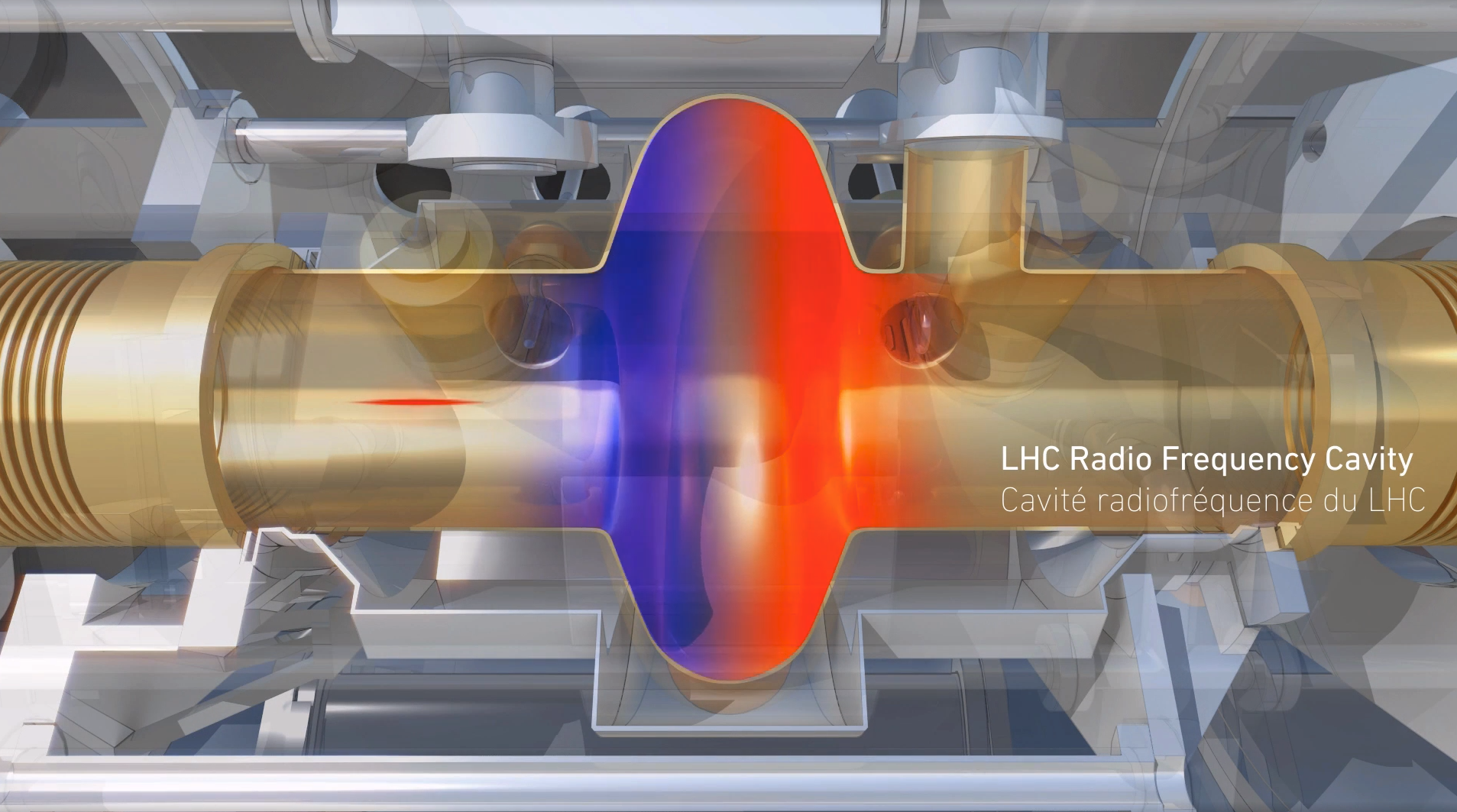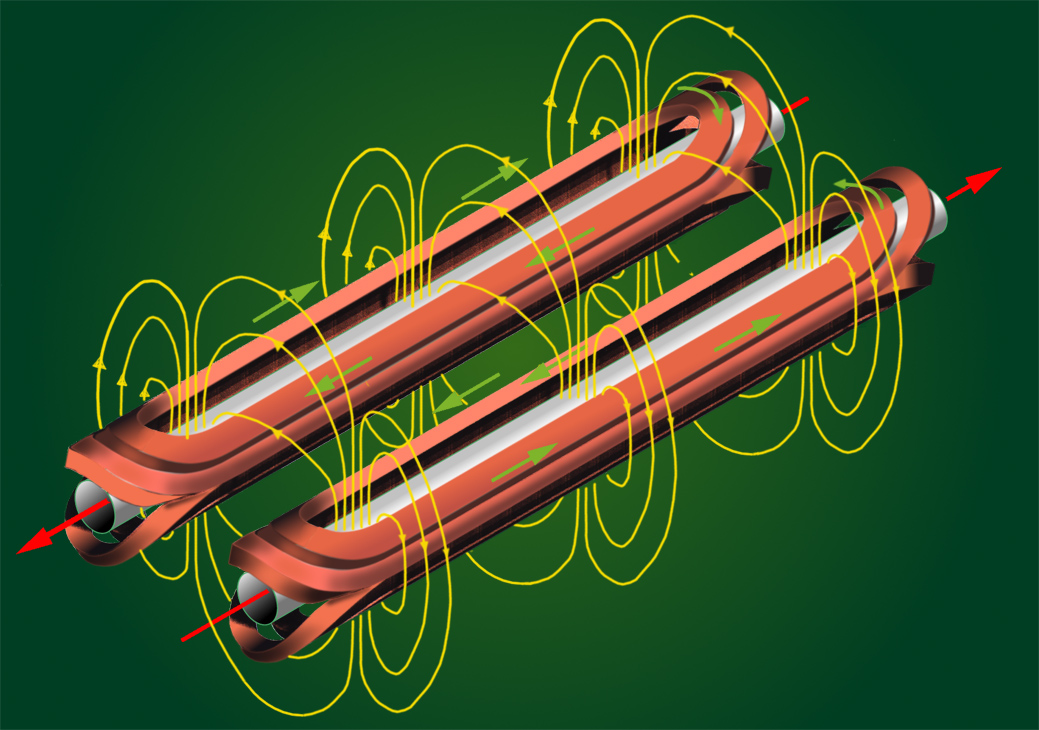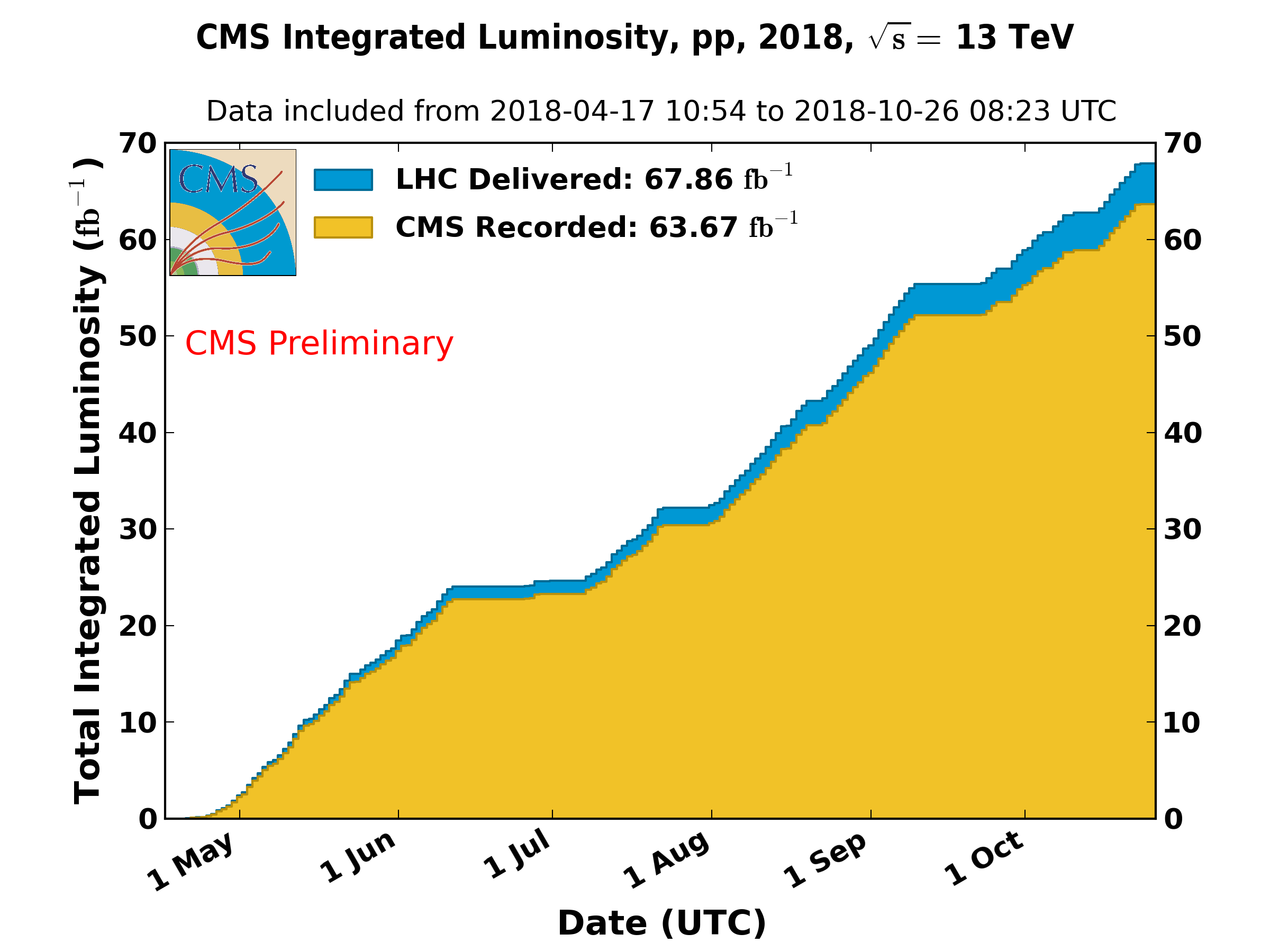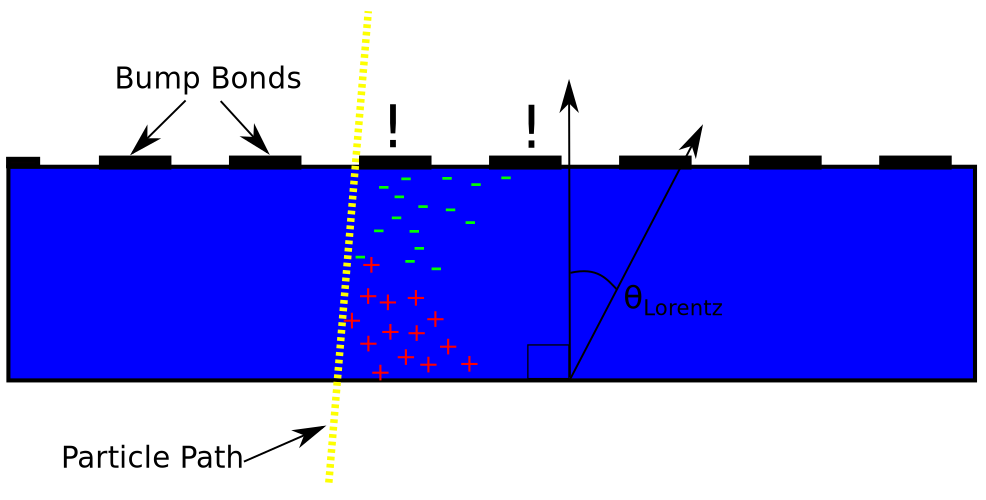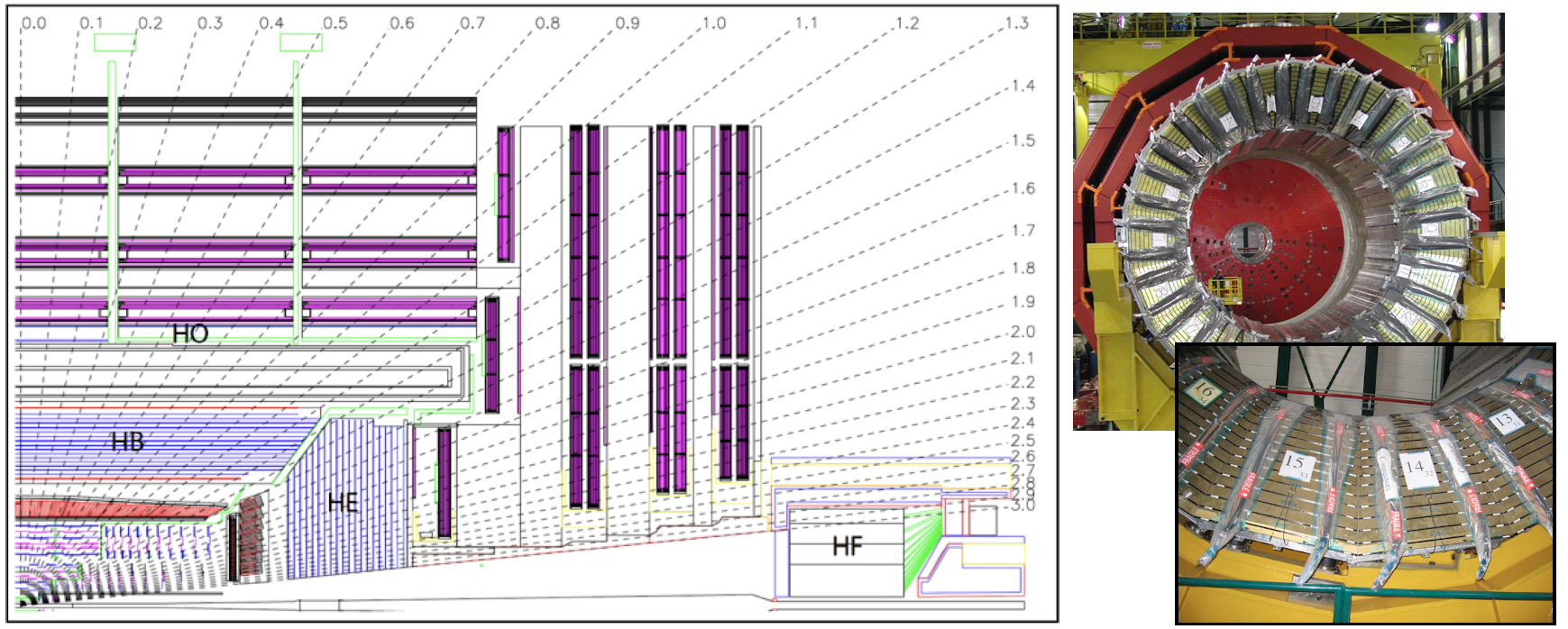03_lhc_and_cms_detector.md 16 KB
title: The LHC and CMS Detector ...
Introduction
Lying buried beneath Geneve Switzerland and stretching across the border into France is the largest machine ever constructed by mankind. This marvel of physics and engineering is operated by CERN, the European Organization for Nuclear Research[^1]. The Large Hadron Collider (LHC) is a circular particle accelerator with a circumference of 27 km and is capable of creating proton-proton collisions with up to 13 TeV of energy in the center-of-mass frame. CERN itself is a huge organization, comprising roughly thirteen thousand people with diverse backgrounds and disciplines. The goal of the LHC and associated experiments is to increase humanity's fundamental understanding of the nature of the Universe. It does this by studying the unique properties of matter in the extreme conditions created in very high energy particle collisions. These properties examined by constructing sophisticated particle detectors around the several designated points around the LHC ring. These detectors are marvels unto themselves, often designed and operated by collaborations of thousands of physicists and engineers from across the world. The principle detectors on the LHC ring are ALICE, ATLAS, CMS, and LHCb. ATLAS and CMS are general purpose detectors, facilitate a wide range of physics measurements. ALICE specializes in exploring the physics around heavy-ion collisions, exploring, among other things, the dynamics of the quark-gluon plasma that gets created during the LHC's heavy-ion runs. LHCb is another specialized detector that focuses on phenomena related to the bottom quark.
[^1]: Acronym derived from the original French: "Conseil Européen pour la Recherche Nucléaire"
The LHC
After initial setbacks in 2008[@quench2008], The LHC began supplying collisions for physics research in 2010 with collision energies of 7 TeV. It operated successfully over the next few years, delivering the $5\mathrm{fb}^{-1}$ of integrated luminosity that resulted in the joint discovery by CMS and ATLAS of a new particle with a mass of 125 GeV identified as the Higgs boson[@1207.7214;@1207.7235].
The LHC complex is shown in [fig:lhc_complex]. Before entering the LHC, protons are collected, bunched, accelerated by several steps. The protons originate as hydrogen atoms that have been ionized by a strong electric field. The $H^+$ ions (i.e. protons) are then accelerated to 50 MeV by the LINAC2 linear accelerator. They are then transferred to the Proton Synchrotron (PS) which further accelerates the protons to 26 GeV. Next, they are injected into the Super Proton Synchrotron (SPS) which pushes their energy to 450 GeV before finally entering the LHC and being pushed to 6.5 TeV. There are two separate injection pathways for injecting protons into the clockwise and the counterclockwise beam channels.
The actual acceleration of the protons is done with superconducting radio-frequency (RF) cavities ([@fig:rf_cavity]). The LHC has a system of 16 of these cavities concentrated at Point 4 along the ring. To bend the proton beam around the LHC ring, superconducting dipole magnets are used. [@Fig:lhc_dipole_cartoon] demonstrates how these magnets act to steer the beam. The LHC has 1232 such magnets distributed around eight curved sections of the ring, the curved sections being 2.45 km long each and separated by 545 m long straight sections containing the RF acceleration system, beam dump, and detector halls.
The bunches of protons will inevitably have some transverse momentum spread, exacerbated by the repulsive Coulomb force amongst the protons in each bunch. To account for this, sextupole magnets are employed to condition the beam. As it travels around the LHC ring, the bunches have a transverse diameter of roughly 1 mm and is approximately 7.5 cm long. As the beam approaches each of the interaction points, quadrupole magnets are used to focus the beam down to having a width of just 16 $\mu \mathrm{m}$ in order to increase the average number of collisions as the opposing beams cross. The number of interactions that occur upon each bunch-crossing is tuned to balance maximizing the total number of collisions with what the detector can effectively handle. If there are too many simultaneous interactions in a single bunch crossing, the detector's electronics are at risk of buffer overflows, leading to data loss. It also increases, potentially dramatically, the amount of computing resources that are required to reconstruct each event. Track reconstruction in particular can become prohibitively expensive as the number of interactions grows. In any case, the instantaneous luminosity, directly related to the number of interactions per bunch-crossing, can be calculated using
$$L = fn\frac{N^2}{4\pi\sigma^2}$$ {#eq:inst_lumi}
In the above equation, $f$ is the orbit frequency of bunches around the LHC ring, $n$ is the number of bunches per beam. So, $2fn$ is effectively the bunch-crossing frequency[^2]. $N$ is the number of protons per bunch and $\sigma$ is the Gaussian width of the beam, assuming the beam is cylindrically symmetric. In 2018, CMS would typically receive peak instantaneous luminosities of roughly 20 Hz/nb[@cms_lumi2018]. Integrating the instantaneous luminosity against time yields, unsurprisingly, the integrated luminosity. This, together with the collision energy, largely dictate what sort of physics one can expect to study at a collider experiment. The integrated luminosity delivered and recorded by CMS in the 2018 data-taking run is shown in [@fig:cms_intlumi_2018].
[^2]: Twice $fn$ due to two beams orbiting in opposite directions.
The CMS Experiment
Of the several sophisticated detectors arrayed around the LHC ring, this thesis focuses on the Compact Muon Solenoid (CMS) experiment. CMS is designed with nested layers serving different purposes. [@Fig:cms_overview] shows the CMS detector with its subsystems. These subsystems include:
- Silicon Trackers
- Crystal Electromagnetic Calorimeter (ECAL) and Preshower
- Hadron Calorimeter (HCAL)
- Superconducting Solenoid magnet
- Muon Chambers
Silicon Tracking System
The silicon tracker consists of many layers of silicon pixel and strip detectors that record where charged particles pass through each individual layer. Sophisticated tracking software is then used to link together individual "hits" in the layers to form a coherent track describing the real path of the particle.
Both pixel and strip silicon detectors operate on the same principle. A sheet of silicon, typically a few hundred microns thick, is fabricated with a p-n junction running through it. Electrically it is little more than an oddly shaped diode. The "diode" is then reverse-biased. A typical diode used in electronics preferentially allows current to flow through it in one direction leading to an current vs voltage (IV) curve as shown on the left of [@fig:pixel_rev_bias]. In this reverse bias state, all mobile charge carriers have been evacuated from the bulk. However, if the reverse voltage continues to grow, external charge carriers will be able to jump across the junction, leading to "breakdown" and a large increase in current. During manufacturing, silicon for particle detectors goes through qualification that ensures its breakdown voltage is sufficiently high. The left plot in [@fig:pixel_rev_bias] shows the current vs reverse voltage for several silicon detector sensors.
When a silicon sensor is reverse-biased, there is normally only a tiny "leakage" current that flows through it. However, when an energetic charged particle such as an electron, muon, proton, etc. passes through the sensor, it interacts with the atoms in the material to raise orbital electrons into the conduction band of the semiconductor. This creates electron-hole pairs that drift apart due to the electric field resulting from the reverse bias voltage. Eventually, this charge reaches the surface where it is collected by conductive strips (strip detector) or bump bonds (pixel detectors) to be fed into a nearby readout chip. This is illustrated in [@fig:sensor_drift]
The original, or Phase-0, CMS tracker had three layers of pixel detectors in the barrel region and two on each forward region ([@fig:phase0_tracker]). In 2017, an upgraded version of the pixel detector was installed that increased the number of layers to four in the barrel and three in each forward region. For both detectors, the pixels were 100 $\mu \mathrm{m}$ by 150 $\mu \mathrm{m}$. More information on the upgrade project and the pixel detector can be found in Chapter 6.
Surrounding the pixel detector is the silicon strip tracker. As shown in [@fig:strip_tracker], the strip tracker has four sections: the inner and outer barrel, the inner disks, and the endcap. The pitch of the strips in the different sections has been tuned to balance reconstruction precision, occupancy, and construction practicality, resulting in strips ranging in width from as small as 80 $\mu\textrm{m}$ in the TIB to 180 $\mu\textrm{m}$ in the outer layers of the TOB and TEC. The strips are oriented along the z-axis for the barrel and along the radial direction for the endcap layers. There are also two layers of double-sided strip detectors in the TOB with one side rotated 100 mrad relative to the other. Together, these two sides can give a 3d position measurement[@Fernandez2007].
Electromagnetic Calorimeter
After leaving the tracker, particles reach the ECAL. Electrons and photons interact strongly with the material in the crystals to create an electromagnetic shower. The shower occurs when electrons interact with the atoms of the material to release Bremsstrahlung, or braking, photons. If the photons are energetic enough, they also interact with the material to produce electron-positron pairs which will continue the shower. This process continues until the particles no longer have enough energy to support the aforementioned processes. The deposition of energy from the shower into the ECAL crystals is used to help reconstruct photons and electrons in the original event.
The ECAL used by CMS is built with 75,848 lead tungstate ($\mathrm{PbWO}_4$) crystals. Lead tungstate was chosen for its high density (8.3 g/$\mathrm{cm}^3$), and short radiation length ($X_0$=0.89 cm). It it also desirable because it tends to produce well-collimated, narrow showers, having a Molière radius of 2.2 cm. The electromagnetic showers inside the ECAL crystals produce scintillation light which is captured and amplified by avalanche photodiodes (APDs).
To augment the ECAL, the preshower detector (ES) is installed just inside the forward ECAL. It addresses an peculiar issue resulting from neutral pions. These particles will commonly be produced with high enough momentum that when they decay ($\pi^0\rightarrow \gamma \gamma$), the photons will be so narrowly separated that the ECAL is at risk of identifying them as a single very high energy photon. Because Higgs searches were an important driver in the design of CMS, and $H\rightarrow \gamma \gamma$ was a potential discovery channel, the PS was added to help reduce the number of $\pi^0$ misidentified as high energy photons. The PS is constructed with alternating layers of lead and silicon detector, the first to initiate a shower, and the second to give a high precision measurement of the shower-in-progress. This gives sufficient granularity to identify the narrowly separated photons from $\pi^0$ and other di-photon resonances.
Hadronic Calorimeter
Electrons and photons are effectively stopped in the ECAL. What remains is are muons and hadrons. The muons continue largely unimpeded through the HCAL, but hadrons are stopped by the dense layers of brass and scintillating plastic. The HCAL operates on a similar principle to the ECAL, except the initial reaction is mediated by the strong force as an incident hadron interacts with an atomic nucleus of material in the HCAL. The products of this reaction may go in to have additional nuclear interactions, if they are themselves hadrons, or start electromagnetic showers if they are photons or electrons. The brass layers serve as the absorber, the material chosen for being non-ferromagnetic and having a short interaction length ($\lambda_I = 16.42$ cm). The scintillators are equipped with silicon photomultipliers (SiPM) and together they sample the hadronic "shower" as it traverses a particular layer. These samples are then used to calculate the energy of the initial particle.
The HCAL is divided into a barrel region (HB) and endcaps (HE) in the forward regions that sit inside the solenoid coil. There is also an additional layer (HO) that sits outside the magnet to provide a cumulative 11 interaction lengths of material so the shower is completely captured within the calorimeter.
